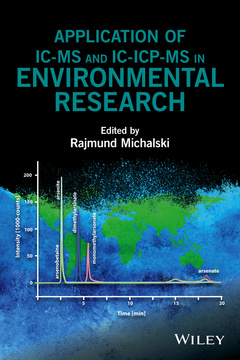Description
Application of IC-MS and IC-ICP-MS in Environmental Research
Coordinator: Michalski Rajmund
Language: English
Subject for Application of IC-MS and IC-ICP-MS in Environmental Research:
288 p. · 16x23.6 cm · Hardback
Description
/li>Contents
/li>Biography
/li>
- Covers the importance of species analysis and hyphenated methods in ion chromatography
- Includes practical applications of IC-MS and IC-ICP-MS in environmental analysis
- Details sample preparation methods for ion chromatography
- Discusses hyphenated methods IC-MS and IC-ICP-MS used in determining both the total element contents and its elements
- Details speciation analysis used in studying biochemical cycles of selected chemical compounds; determining toxicity and ecotoxicity of elements; food and pharmaceuticals quality control; and in technological process control and clinical analytics
List of Contributors ix
Preface xi
1 Principles and Applications of Ion Chromatography 1
Rajmund Michalski
1.1 Principles of Ion Chromatography, 1
1.1.1 Introduction, 1
1.1.2 Stationary Phases, 6
1.1.3 Eluents, 13
1.1.4 Suppressors, 16
1.1.5 Detection Methods, 18
1.2 Ion Chromatography Applications, 23
1.2.1 Speciation Analysis with the Hyphenated Methods of IC-ICP-MS and IC-MS, 29
1.3 Sample Preparation for Ion Chromatography, 32
1.4 Selected Methodological Aspects of Ion Determination with Ion Chromatography, 34
1.5 Ion Chromatography Development Perspectives, 37
1.6 References, 37
2 Mass Spectrometric Detectors for Environmental Studies 47
Maria Balcerzak
2.1 Introduction, 47
2.2 Mass Spectrometric Detectors, 49
2.2.1 Ionization Methods, 50
2.2.2 Mass Analyzers, 58
Acknowledgments, 62
2.3 References, 62
3 High-Performance Liquid Chromatography Coupled to Inductively Coupled Plasma MS/Electrospray Ionization MS 79
Jürgen Mattusch
3.1 Separation Principles, 79
3.1.1 Ion Chromatography (Anion/Cation Exchange, Mixed Mode), 80
3.1.2 High-Performance Liquid Chromatography (Reversed-Phase Mode, HILIC), 81
3.1.3 Size Exclusion Chromatography (SEC) (Gel Filtration Chromatography, GFC), 82
3.2 Detection Principles, 83
3.2.1 Common Detection in IC: Conductivity, UV–Vis, Electrochemical Detection, 83
3.2.2 Element Specific Detection, 83
3.3 Hyphenated Techniques, 87
3.3.1 HPLC(IC)–ICP-MS, 87
3.4 HPLC(IC)–ICP-MS/ESI-MS, 90
3.4.1 Fundamentals, 90
3.4.2 Methodology of Data Evaluation, 90
3.4.3 Technical Requirements, 91
3.5 Applications and Conclusion, 91
3.6 References, 102
4 Application of IC-MS in Organic Environmental Geochemistry 109
Klaus Fischer
4.1 Introduction, 109
4.2 Carboxylic Acids, 114
4.2.1 Molecular Structure, Molecular Interaction Potential, and Chromatographic Retention, 114
4.2.2 Environmental Analysis of Carboxylic Acids by Ion Exclusion Chromatography–Mass Spectrometry (HPICE-MS), 116
4.2.3 Environmental Analysis of Carboxylic Acids by Ion-Exchange Chromatography–Mass Spectrometry (HPI-EC-MS), 124
4.3 Carbohydrates, 135
4.3.1 Structural Diversity and Ion Chromatographic Behavior, 135
4.3.2 Environmental Analysis of Carbohydrates by Various IC-MS Methods, 136
4.4 Amines and Amino Acids, 143
4.5 Trends and Perspectives, 144
4.6 References, 145
5 Analysis of Oxyhalides and Haloacetic Acids in Drinking Water Using IC-MS and IC-ICP-MS 152
Koji Kosaka
5.1 Introduction, 152
5.2 Source of Oxyhalides and HAAs, 154
5.3 Analysis of Oxyhalides and HAAs, 158
5.3.1 Suppressed IC-MS, 158
5.3.2 Nonsuppressed IC-MS and LC-MS, 162
5.3.3 IC-ICP-MS, 165
5.4 Application for Monitoring of Oxyhalides and HAAs in Drinking Water, 166
5.4.1 Oxyhalides, 166
5.4.2 HAAs, 171
Summary, 171
5.5 References, 172
6 Analysis of Various Anionic Metabolites in Plant and Animal Material by IC-MS 178
Adam Konrad Jagielski and Michal Usarek
6.1 Introduction, 178
6.2 Optimization of HPIC and Ms Settings, 179
6.2.1 HPIC Settings, 179
6.2.2 MS Settings, 183
6.2.3 HPIC-MS Settings, 185
6.2.4 Extraction of Metabolites from Cells and Tissues, 189
6.3 Application of the Method in Analysis of Metabolites in Plant and Animal Material, 191
6.3.1 Analysis of Metabolites from Cell Cultures (Primary Cultures as well as Established Cell Lines), 192
6.3.2 Analysis of Metabolites from Solid Tissues, 192
6.3.3 Extraction of Metabolites from Plants, 194
6.4 Conclusions, 196
6.5 References, 197
7 Analysis of Perchlorate Ion in Various Matrices Using Ion Chromatography Hyphenated with Mass Spectrometry 199
Jay Gandhi
7.1 Introduction, 199
7.2 Precautions Unique to Ion Chromatography–Mass Spectrometry, 200
7.2.1 Instrumental and Operating Parameters, 201
7.3 Results and Discussion, 204
Acknowledgment, 209
7.4 References, 209
8 Sample Preparation Techniques for Ion Chromatography 210
Wolfgang Frenzel and Rajmund Michalski
8.1 Introduction, 210
8.2 When and Why is Sample Preparation Required in Ion Chromatography? 213
8.3 Automation of Sample Preparation (IN-LINE Techniques), 215
8.4 Sample Preparation Methods, 217
8.4.1 Filtration and Ultrafiltration, 219
8.4.2 Solid-Phase Extraction (SPE), 220
8.4.3 Liquid–Liquid Extraction, 225
8.4.4 Gas-Phase Separations, 226
8.4.5 Precipitation, 226
8.4.6 Membrane-Based Separations and Sample Treatment, 227
8.5 Trace Analysis and Preconcentration for Ion Chromatographic Analysis, 238
8.5.1 Preconcentration Using SPE, 239
8.5.2 Membrane-Based In-Line Preconcentration, 241
8.6 In-Line Preseparations Using Two-Dimensional Ion Chromatography (2D-IC), 243
8.7 Sample Preparation of Solid Samples, 244
8.7.1 Dissolution and Aqueous or Acid Extraction, 246
8.7.2 Wet-Chemical Acid Digestions, 247
8.7.3 UV Photolytic Digestion, 248
8.7.4 Fusion Methods, 249
8.7.5 Dry Ashing and Combustion Methods, 249
8.8 Air Analysis Using Ion Chromatography – Application to Gases and Particulate Matter, 251
8.9 Postcolumn Eluent Treatment Prior to Ms Detection, 255
8.10 Concluding Remarks, 257
8.11 References, 258
Index 267




